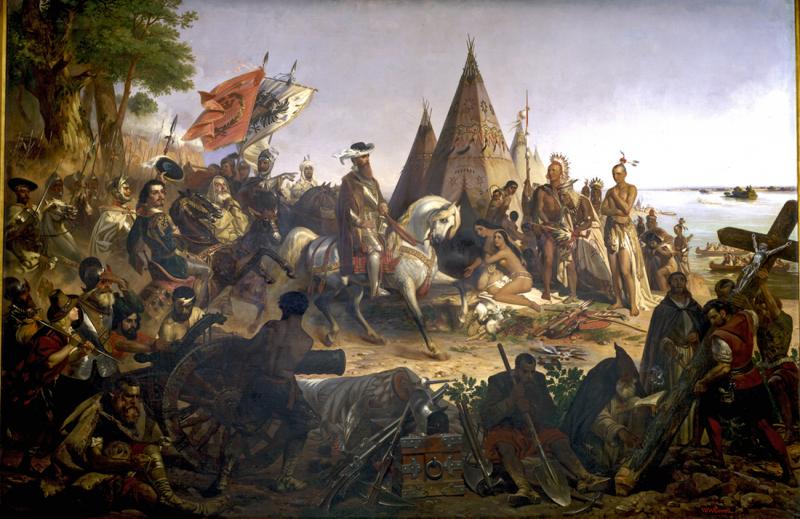Discovery of the Mississippi by De Soto
William H. Powell's painting, Discovery of the Mississippi by De Soto, depicts Hernando de Soto's encounter with the Mississippi River in 1541. De Soto was the first European to view the river. In the painting, de Soto appears in armor on a white horse, approaching a vista of the large river. De Soto is flanked by armored men carrying spears and flags. A group of American Indians stand and kneel next to the path on which de Soto is riding. Two of the women appear to be frightened, and one of the men is holding a peace pipe. In the background, Indians in canoes are rowing in the water. In the foreground on the right, a group of European men are planting a crucifix in a freshly dug hole. In the foreground on the left, another group of Europeans are wheeling a cannon. The painting was commissioned by the United States Congress to hang in the Rotunda in the U.S. Capitol building in 1847. Powell (1823-1879) was the last artist to be commissioned by the Congress for a painting in the Rotunda.

Powell, William H. "Discovery of the Mississippi by De Soto." Oil on canvas. 1855. 12' x 18'. Washington, D.C. Capital Rotunda. https://www.aoc.gov/explore-capitol-campus/art/discovery-mississippi-de-....
Public Domain
Public Domain is a copyright term that is often used when talking about copyright for creative works. Under U.S. copyright law, individual items that are in the public domain are items that are no longer protected by copyright law. This means that you do not need to request permission to re-use, re-publish or even change a copy of the item. Items enter the public domain under U.S. copyright law for a number of reasons: the original copyright may have expired; the item was created by the U.S. Federal Government or other governmental entity that views the things it creates as in the public domain; the work was never protected by copyright for some other reason related to how it was produced (for example, it was a speech that wasn't written down or recorded); or the work doesn't have enough originality to make it eligible for copyright protection.